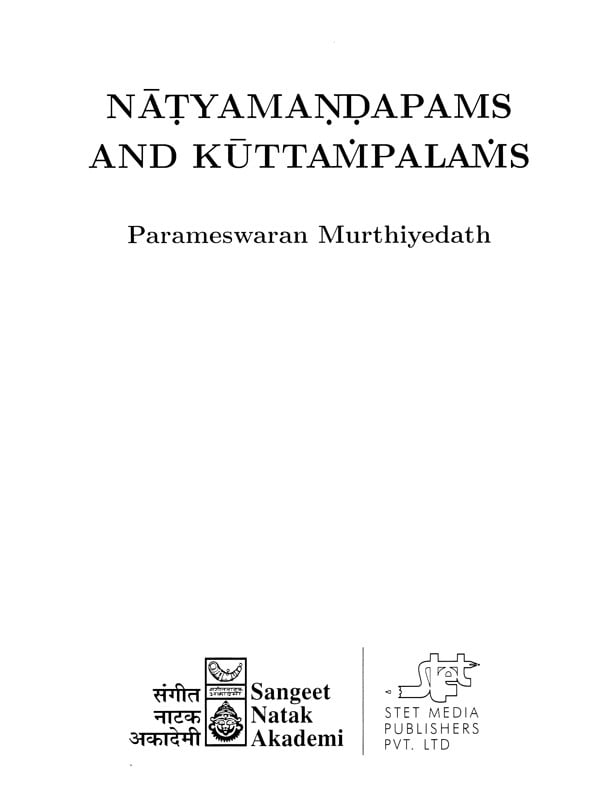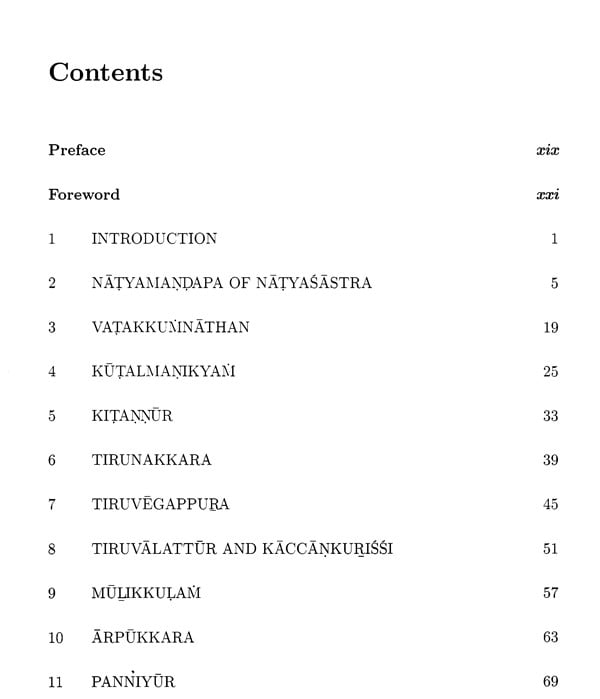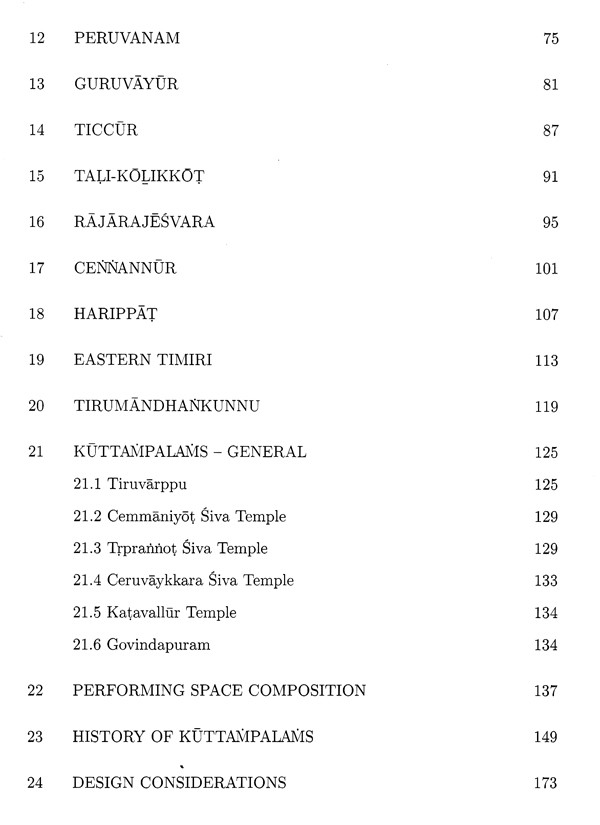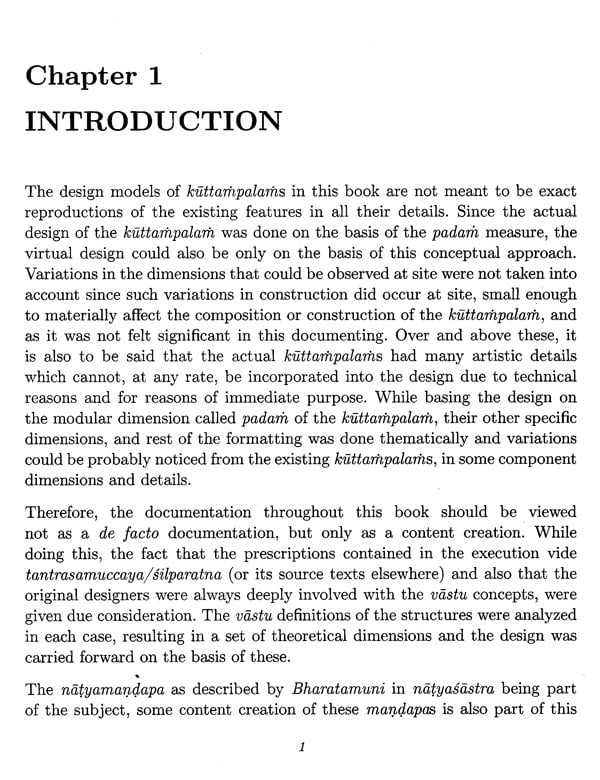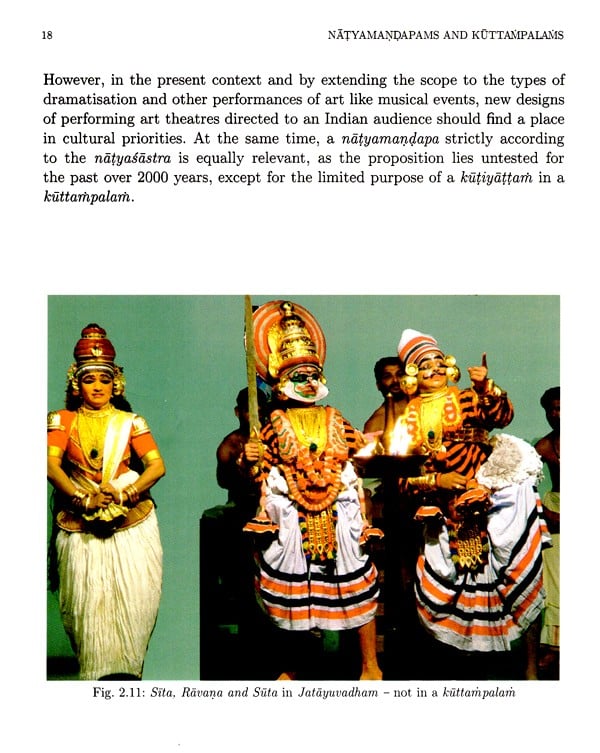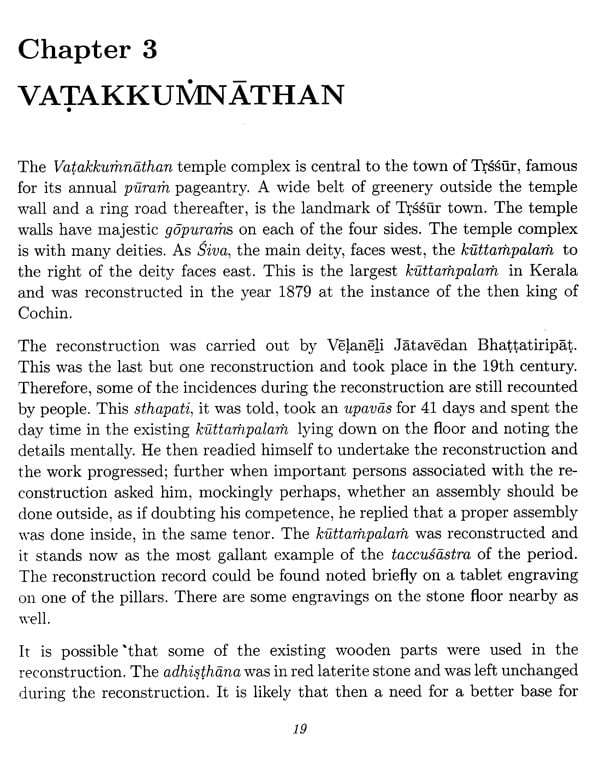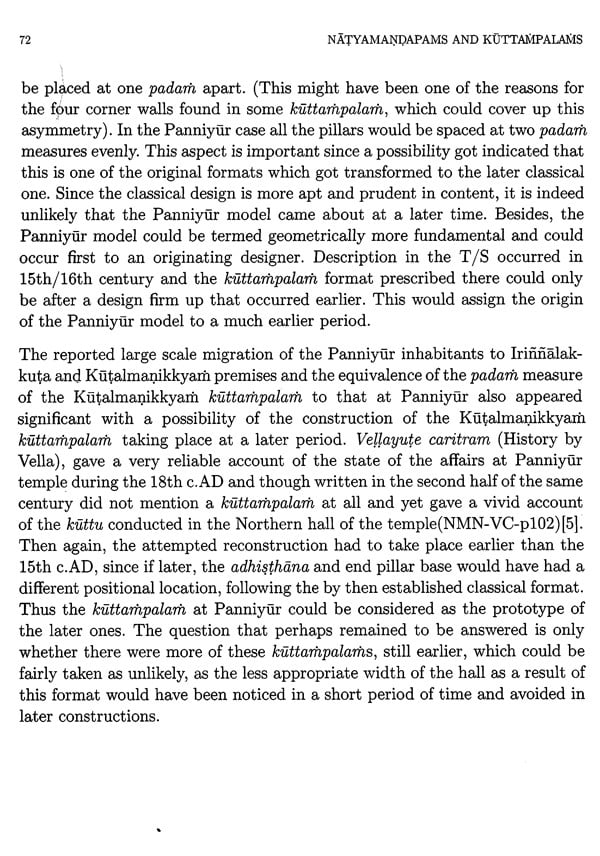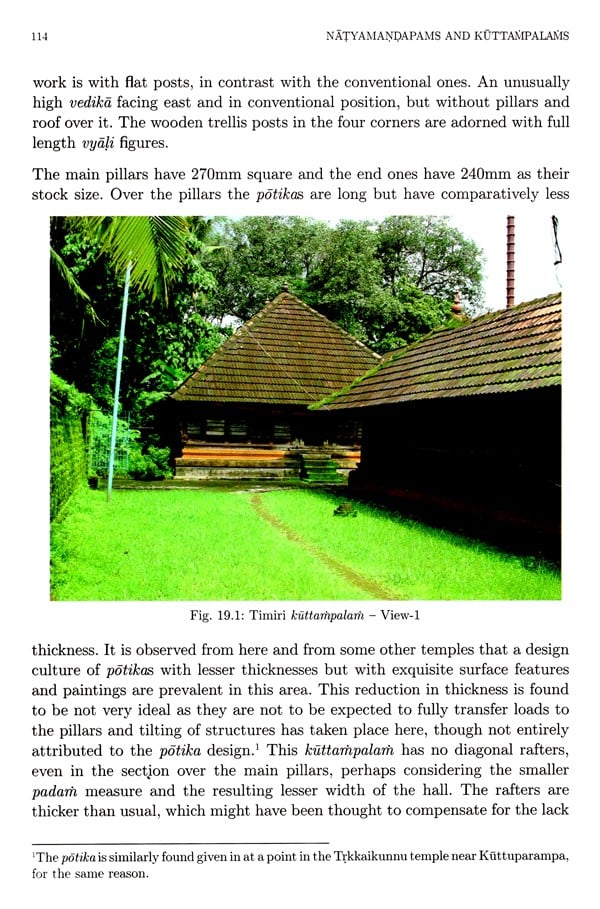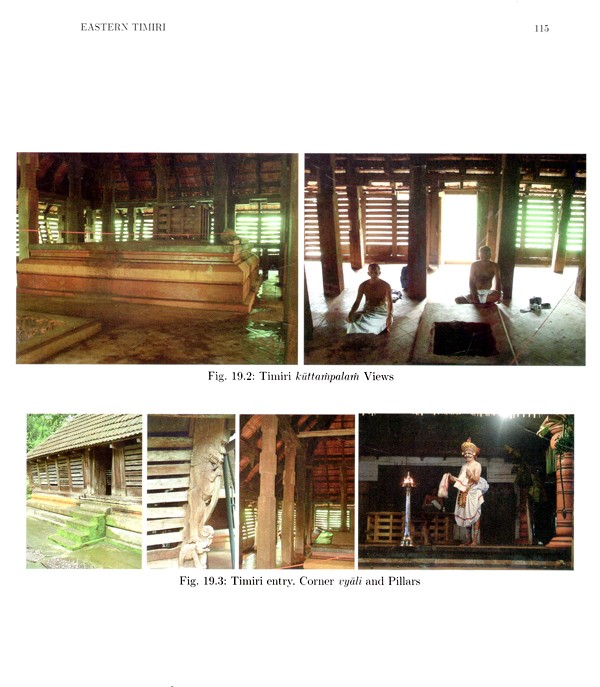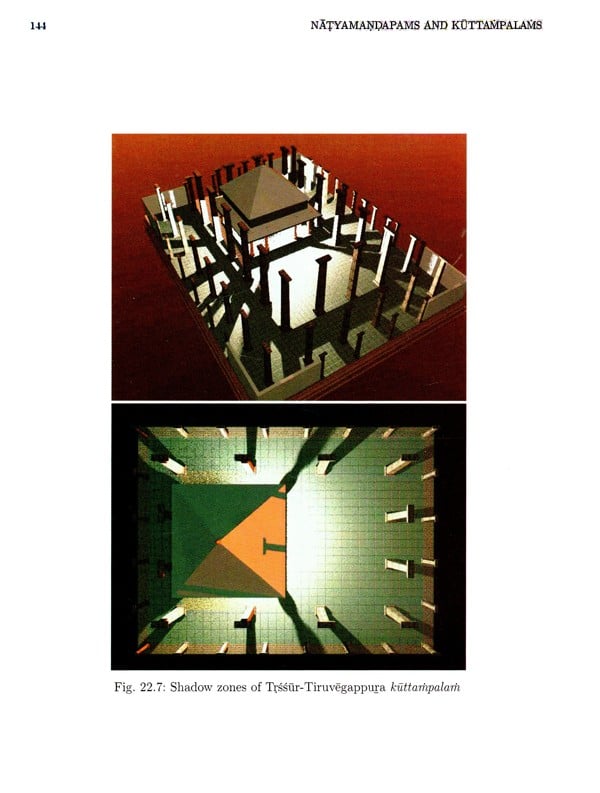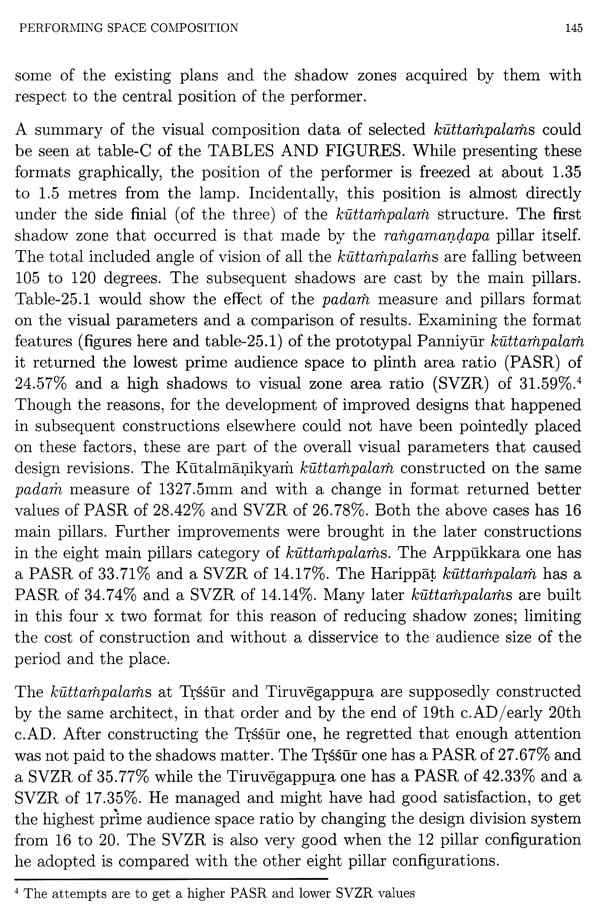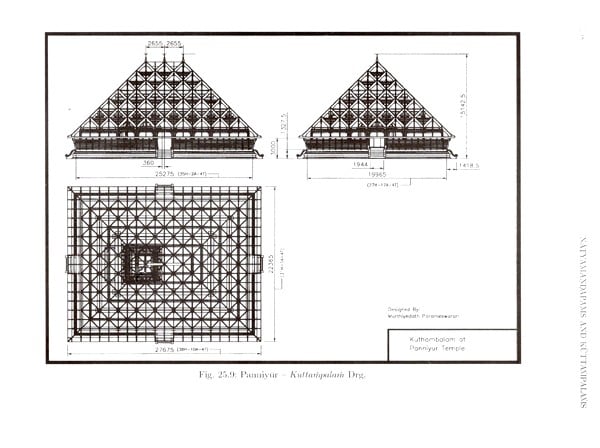
Natyamandapams and Kuttampalams
Book Specification
| Item Code: | UAZ040 |
| Author: | Parameswaran Murthiyedath |
| Publisher: | SANGEET NATAK AKADEMI, DELHI |
| Language: | English |
| Edition: | 2022 |
| ISBN: | 9788195560226 |
| Pages: | 248 (Throughout Color and B/w Illustrations) |
| Cover: | PAPERBACK |
| Other Details | 9.50 X 7.00 inch |
| Weight | 730 gm |
Book Description
Natyasdstra by Bharatamuni is believed to have been written circa 2nd c. BC and describes the notyamandapa, where the performances were meant to be held. The concepts and requirements of the construction of the natyamandapas have been prescribed in good detail in the Natyaśöstra. The author follows a meticulous documentation of the natyamandapas and küttampalams in different parts of the southern State of Kerala. Since a natyamandapa as described in the Ndtyofdstra is not found anywhere else in India, this book should create a new interest in the subject. All the architectural and engineering data presented in the book have been culled from the respective design files of each küttampalam. It is hoped that this book would receive acceptance and will be accessed by the discerning readers who are interested in the subject.
Parameswaran Murthiyedath (1943-2022) was an engineer who had been engaged in the study of the ancient traditions of geometry of India for decades. Author of more than eleven books such as Yogna Vedikal (2006), Prasnopanishad (2009), Vedarthaparichayam (2013), Vedic Cosmology (2018), Ancient Indian Geometry (2021), Pracinajyomiti (2021), Boudhayana Sulbasutram (2021), Katyayana Sulbasutram (2022), Vedic Principles of Success (2022), and The Divine Science of Rig Veda (2022), Parameswaran Murthiyedath had taken up this highly technical book which will be of interest to architects, civil engineers, mathematicians as well as art historians. It will be equally of interest to the students of theatre and the dramatic tradition in India in general and Kerala in particular. The book offers plenty of interesting information to the historians who are not only concerned with the development of art and culture in a general way but also in studying the processes of development in society.
While practicing engineering design by 3D modelling, my attention per chance turned to the design of the traditional buildings of Kerala. Taccusastra and carpentry thus became a subject of study. The küttampalarhs were found to be the finest examples of design excellence, geometrical concepts and execution marvel. I approached Sri Killimangalam Vasudevan Nambatirippad. my maternal uncle who spoke to me on various aspects of the kütiyaṭṭam, as relevant to the theatre organisation. I was also introduced to Dr. Narayanan Mundayil, Asst. Professor at Miyazaki University, Japan who provided me with a set of photo-visuals of Vatakkumnathan. Kütālmanikyam and Mülikkulam küttarhpalaris. He also discussed at length some of the visual concepts of the rangamandapa and other matters and later interactions with him had helped to have a more clear approach to the subject. He put me on to Sri L.S. Rajagopalan, Trésür, a well known personality in küttam palarh matters and classical music. The discussion with him on the concepts of the küttam palam and the rangamandapa was again highly useful.
After getting into the basic concepts of the küțiyaṭṭam and the geometrical fundamentals of a küttampalam design (i.e., to a practical level), programmes were made for visiting as many of the küttam palams as possible. It was thought that the Indian theatrical concepts of the natyamandapa of nätyasästru should be looked into for the study and the Malayalam translation by late K.P. Narayana Pisaroți was the very authentic source. My work schedule consisted of photography of the küttampalaris, and the temples where they stood and also taking on-site measurements. Sri Narayanan Muttattukat, a photographer by profession, gave a very helping hand in this, in the search for the probable and scattered sites and also collecting of texts in context. He also provided the kutiyäṭṭam photographs, mostly taken by him earlier.
It is with great pleasure, and some trepidation, that I present this extremely important work before the world of scholarship. My pleasure is for two reasons. For one thing, Śri Parameswaran is such a good friend and to see his hard labour coming to fruition is indeed a matter of great delight. Above this personal level, however, is an academic level at which I feel immensely happy: Parameswaran, an engineer by training and profession, having completed a study largely using his own professional equipment and strategies of 3D modelling has chosen to be a student of history to launch his scholarly work. This augurs well for the future of science in the country: it certifies to the increasing awareness that it is only at its own expense that physical and natural sciences can ignore social sciences. By showing this concern, therefore, Parameswaran goes beyond giving expression to his weakness for a personal friend. He is making a statement, loud and clear. And that is also the reason for my trepidation.
What Parameswaran has taken up in this highly technical book is of great interest to architects, civil engineers, mathematicians and a whole lot of other scientists. It is equally of interest to the student of theater and the dramatic tradition in India in general and Kerala in particular. It has lessons to offer to the historian as well, not only to one who is concerned with the development of art and culture in a general way but also to one who is interested in studying the processes of development in society. In fact, rather than looking for evidence of society in the survivals of art, the tendency in recent years is to place the development of art within society. What are the factors and social conjunctures which enabled particular expressions of an art and culture at given points of time? Which are the sections of society that made such developments possible and at whose cost? These are some of the issues that the historian seeks to address in the present context. I am confident that Parameswaran's work will go a long way in helping the historian to raise and look for answers to some of these questions in relation to the Sanskrit theatre of Kerala, namely Kütigaffam.
I have no competence to comment on the work of Parameswaran in his areas of design and 3D modelling. However, what he has done in relation to documenting the natyamandapa in Kerala is of great significance. He starts with a discussion of the different varieties of performance halls as prescribed by the great master, Bharata, in relation to the construction of such halls of performance. Following the textual treasure closely, he shows how the details of the natyamandapa, whatever its variety, also lend themselves to metaphysical interpretation. At the same time, the usual belief that things in India were unchanging to the point of stagnation is also given the lie by this exposition: Parameswaran shows, for instance, that what was contained in the primeval Natyasastra of Bharata went on getting adapted to suit local and temporal needs, as for instance, in the Silparatna. More than that, what is important is that details of both the performance and the architecture according to the Natyasastra have influenced domestic architecture in a big way. For instance, mattavärani, which is unquestionably part of the architecture of natyamandapa, shows itself up in ordinary residential structures of South Malabar as the common mettarana Sutradhara has his place in both architecture and theatrical performance: so also, viskambha. The pillars are named after different varnas. An answer to the question about the why of these is a desideratum. To be sure, this is not part of Parameswaran's subject matter; but he forces the eyes of the historian, the student of the theatre and society and other areas of knowledge, open to these and many other questions. Answers are not certainly available here; nor has he raised these questions. Neither is important in this context. It, however, is significant that he throws up the possibility of raising these questions, which will certainly find answers once raised.
The design models of küttampalaris in this book are not meant to be exact reproductions of the existing features in all their details. Since the actual design of the küttampalam was done on the basis of the padam measure, the virtual design could also be only on the basis of this conceptual approach. Variations in the dimensions that could be observed at site were not taken into account since such variations in construction did occur at site, small enough to materially affect the composition or construction of the küttarhpalarh, and as it was not felt significant in this documenting. Over and above these, it is also to be said that the actual küttampalaris had many artistic details which cannot, at any rate, be incorporated into the design due to technical reasons and for reasons of immediate purpose. While basing the design on the modular dimension called padam of the küttampalam, their other specific dimensions, and rest of the formatting was done thematically and variations could be probably noticed from the existing küttarhpalaths, in some component dimensions and details.
Therefore, the documentation throughout this book should be viewed not as a de facto documentation, but only as a content creation. While doing this, the fact that the prescriptions contained in the execution vide tantrasamuccaya/Silparatna (or its source texts elsewhere) and also that the original designers were always deeply involved with the vastu concepts, were given due consideration. The vastu definitions of the structures were analyzed in each case, resulting in a set of theoretical dimensions and the design was carried forward on the basis of these.
**Contents and Sample Pages**
